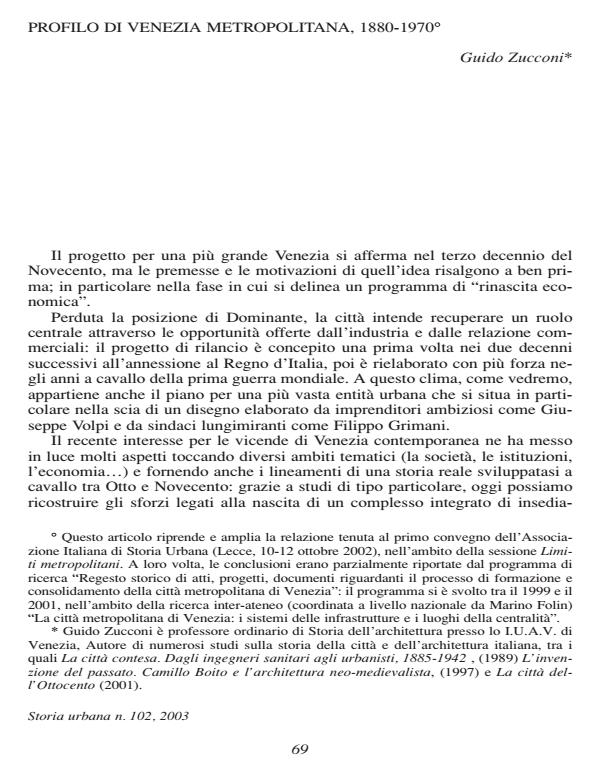Profilo di Venezia metropolitana, 1880-1970
Journal title STORIA URBANA
Author/s Guido Zucconi
Publishing Year 1994 Issue 2003/102
Language Italian Pages 12 P. File size 59 KB
DOI
DOI is like a bar code for intellectual property: to have more infomation
click here
Below, you can see the article first page
If you want to buy this article in PDF format, you can do it, following the instructions to buy download credits

FrancoAngeli is member of Publishers International Linking Association, Inc (PILA), a not-for-profit association which run the CrossRef service enabling links to and from online scholarly content.
Throughout its history of independent city, the limits of Venice were traditionally corresponding to the water fully surrounding the ancient insula. During the XIX century, such a notion of insularity would be radically transformed by a growing number of factors. First in 1846, during the Austrian domination of northeastern Italy, the new railway bridge was built up in the perspective of a long-distance connection to Milan. In the 1880s, a planning scheme was laid out, mostly suggested by the sanitary engineers as the basis of a radical process of modernization. The idea of the planners was also to lessen the urban density and to transfer a large quantity of population to the outskirts. Brought about in 1874, the first enquiry on slum areas had revealed about 35.000 inhabitants living in unbearable conditions. In order to enable the clearance of dilapidated and overcrowded areas, the plan contemplated to resettle a number of people roughly corresponding to one fourth of the total community of the insular Venice. The municipality was looking about new peripheral settlements, such as the Lido, the old island of Giudecca and the new area of Sant’Elena as possible places of destination. Such a concern implied an enlarged notion of city. In the next decades, another problem affected new possible overviews of the city and its limits, that was the proposal of enlarging the port and the area at its backs – the so-called Marittima. New room had to be found elsewhere in order to exploit the opportunities given by new networks of communications. Starting from 1917, a fully equipped industrial port was realized in the area of Marghera, the other side of the lagoon. Together, they created a new residential suburb suitable to the needs of an increasing number of working men. The entire settlement was considered as a new pole within a system of larger connections which has not existed before 1933, when a vehicular link to the mainland was built-up. That was the so-called Littorio bridge, named after one of the masterpieces of Mussolini’s propaganda. Just at the beginning of the Fascist regime, in 1926, a new local body was officially created (the so-called Grande Venezia) including the new settlement of Marghera and the old one of Mestre. The new dimension of Greater Venice was also intended to encircle the insular and maritime sections –the proper Venice and the Lido. The vast industrial area around the new port emerged as the major propeller of the new regional area. Second, some strategic knots were shaped, such as new terminals for cars, ships, airplanes and railroad. Finally, the process started dealing with community facilities such a framework of new poles and networks, the notion of insularity was doomed to an inexorable decline. Venice and its sacred stones had to be theoretically absorbed into the major body of a greater metropolis. In the lagoon, like elsewhere, the traditional urban center is called to give name and significance to the entire conurbation. What makes the difference is the weight of an unchanged idea of Venice strictly connected to the notion of “diversity”. After 1970, the crisis first and the collapse of traditional industry later put aside the role of production in the process of metropolitan configuration. Particularly over the last two decades, the Greater Venice has lost its grounds the commercial port and the industry were moved to the backside area whereas what is centered on the urban core what could be called an Erlebnisstadt has gained a larger room. Due to the change of economic and social perspectives, the whole question of city limits has been once again placed under discussion. Such a story is common to most of the western European countries, but in Venice a particular role has been played by local factors. Both water and outstanding features of the old center have increased and sharpened the divisions among different areas.
Guido Zucconi, Profilo di Venezia metropolitana, 1880-1970 in "STORIA URBANA " 102/2003, pp , DOI: